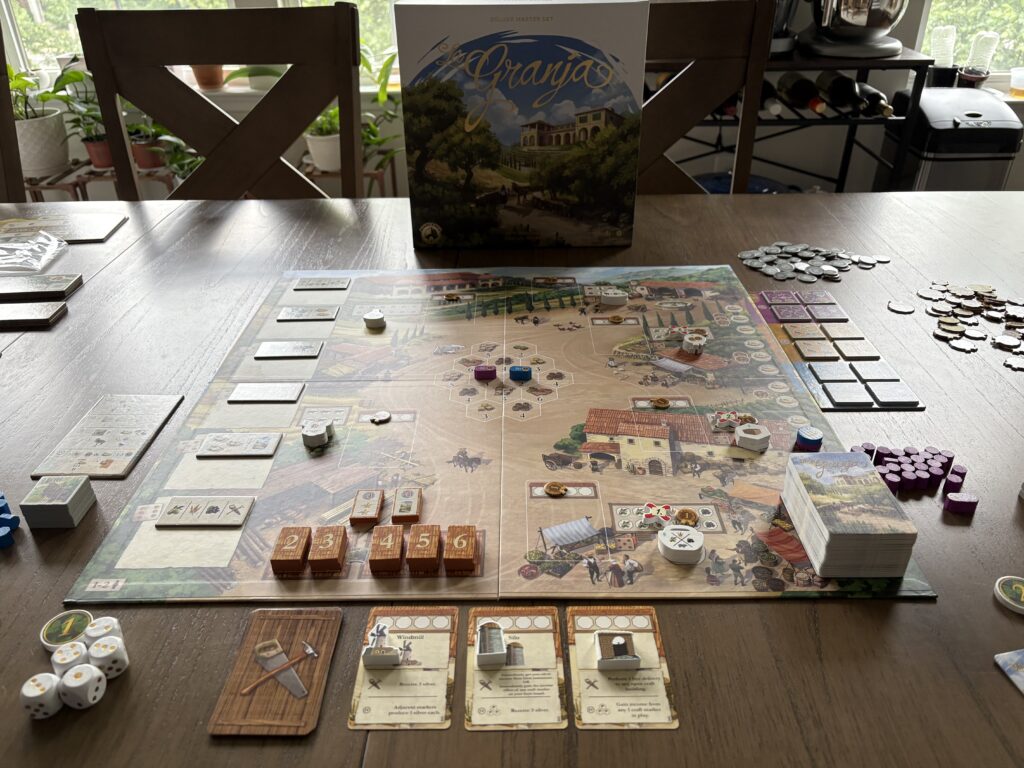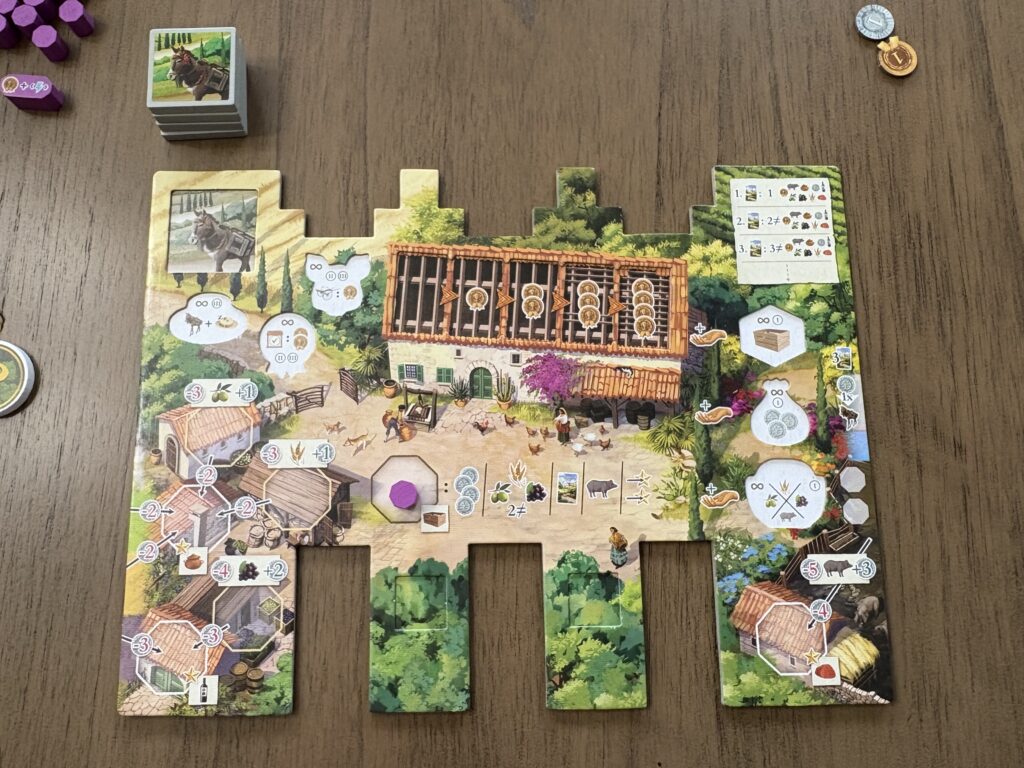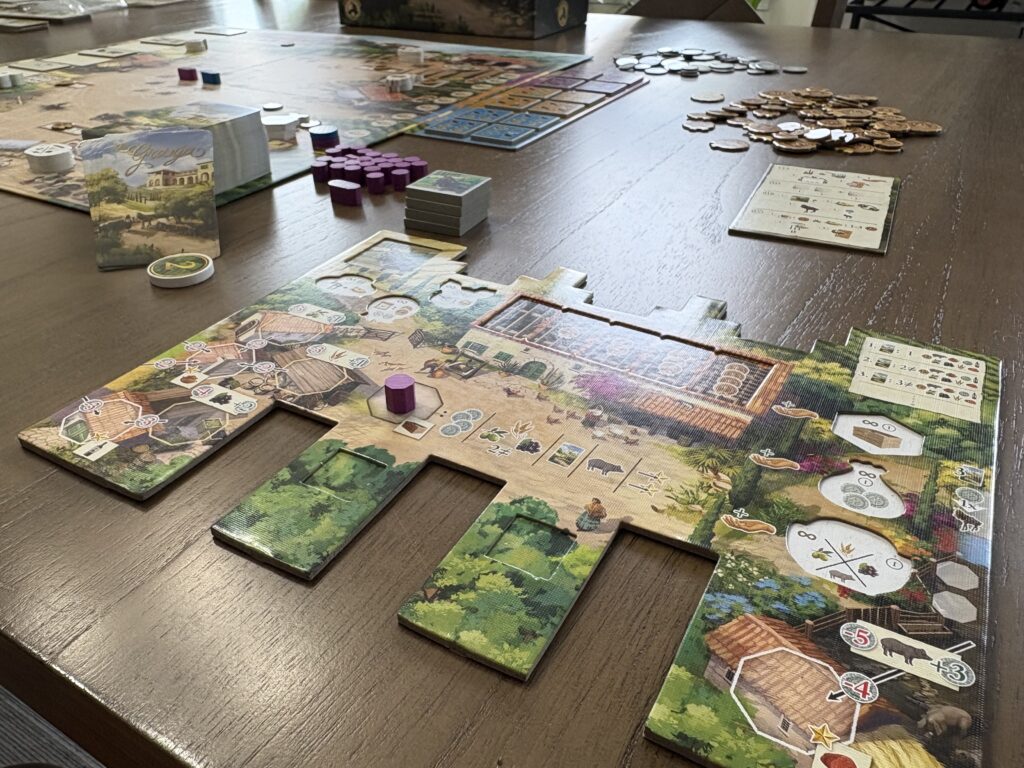Welcome to this week’s review! This week I’m unpacking the deluxified and expanded version of a classic farming game. So without further ado, let’s jump into my thoughts.
La Granja: Deluxe Master Set
- Designers: Michael Keller, Andreas Odendahl, Tony Boydell, Stefan Feld, Kevin Hendranata, Błażej Kubacki, Adam Kwapiński, Andrei Novac
- Publisher: Board & Dice
- Complexity: Medium
- Time: 90-120 Minutes
- Players: 1-4
- Main Mechanisms: Dice Drafting, Contracts, Multi-Use Cards
I’ve never played the original La Granja, so I didn’t quite know what to expect when I decided to jump into the Deluxe Master Set. The reimplementation promises an “upgraded and expanded” version of the 2014 classic, including 12 new modules that can freely be mixed and matched with the base game.

Before I jump into the new modules, let’s first take a look at the base game. La Granja is played over the course of six rounds. Each round consists of four phases which involve players upgrading their farm by playing multi-use cards, drafting dice, and performing deliveries to both central market buildings and personal market cards.
My favorite part of the game by far are the multi-use cards. Each card can be played in one of four ways. The first is by playing the card as a field, allowing the player to produce harvest goods each round, which in turn are used to fulfill deliveries. The second is by playing the card as an extension, allowing the player to generate more income, increase their hand size, perform extra deliveries, or increase the number of pigs they can store. The third way is by playing the card as a personal market borrow which acts as another delivery option. Finally, each card has a unique ability which gives the player benefits for the rest of the game. I love the tactical decision making of determining which cards to prioritize and for which effect. In addition, the permanent abilities on the cards give the game a lot of replayability as they encourage you to focus on different aspects of the game each time.
I tend to enjoy contract mechanisms in games, and fulfilling deliveries in La Granja is incredibly satisfying. Players can choose to fulfill contracts in the central board, which rewards players with permanent abilities for the rest of the game, such as more free deliveries or extra income each round. In addition, players can also fulfill their personal market borrows from played cards, which feeds into an area-control mechanism that can give players points at the end of each round (more on this later). The contracts themselves also give players some early direction while still allowing plenty of options.
I mentioned that I’ve never played the original La Granja, but just comparing the two versions is night and day. The production value of this new deluxe set looks amazing on the table with its beautiful art and components. The only noticeable complaint I have with the production is that I wish the included insert was a bit more functional, and I feel like some space could have been saved to make the box a tad smaller.

Moving on to a few minor complaints – first off, while the rulebook is mostly well done, I wish it was easier to reference. There are some important rules that are buried within different sections, and I almost wish there was a summary in the back of the book for commonly overlooked rules to help jog your memory between games. The rulebook is also quite text heavy, and I wish the pictorial examples were explained in more detail. Overall though, I didn’t have too many FAQ moments with the base rules – just a couple instances with a few of the modules.
I promised that I would return to the central area control mechanism, and this is likely my least favorite part of the game. Whenever a player completes one of their personal market borrows, they get to place one of their player markers on a space in the central area with a value matching that on their completed market borrow card. If there are opponent markers next to the placed marker with a smaller value, those get removed. I don’t have too much of an issue with players being able to remove other players’ markers because players can always choose to focus on completing markers of high values. Rather, my bigger issue with this mechanism is that it didn’t feel entirely balanced or as interesting when playing with only two players. I can imagine that when playing at higher player counts, there is more competition as players are routinely placing and removing markers, but at two players, if one player chooses to focus heavily on this element (with the other player focusing more on the central market buildings), the player that focused more on the area control element tended to win. That is because at the end of each round, players score points based on the number of markers they have on the board, so if one player can control the majority of spaces, it can be difficult for the other player to catch up.
Lastly, I mentioned that I love the multi-use cards, but while I found there are a lot of options, the options themselves feel very similar and the overall shine of the game started to wear a bit with more plays. I imagine that’s where the modules will be useful in helping mix things up, but overall, La Granja feels like a game that I’ll enjoy bringing out occasionally rather than multiple repeat plays.
Modules
Moving on to the modules, I’ll preface that I have yet to try all of them, so these are just my initial thoughts on the ones I’ve played so far.
First up, Donkey Song is a module that adds new donkey tiles that can be bought based on how far players have progressed up the siesta track. This module helps to make the siesta track feel more impactful, rather than just a track that determines player order. Overall, Donkey Song is one of my favorite modules in the set, and I’ll likely always include it, even when teaching to new players.
Ladies of La Granja adds six asymmetric player powers that are drafted at the beginning of the game. This is another module that is an automatic add as the player powers encourage different strategies, while still being easy enough to teach to new players.

Bustling Town likely adds the most changes of any of the modules, and it adds new building cards and markers that give both instant and ongoing effects when constructed, as well as new revenue tiles to mix things up. The building tiles do a lot to make the area control mechanism more interesting, but overall this is a module wouldn’t be an automatic add each game. I’ll likely play with it occasionally when looking to mix things up, and I’d recommend leaving this module out when playing with new players.
Next up is Grand Markers. This adds two new markers for each player, which players can use when they make two consecutive and adjacent deliveries to the same craft building or market borrow. This module is interesting, but also feels more situational. I’ll likely include it more often than not, since it’s easy to include, but I wouldn’t consider it essential or one I would include with new players.
Lastly, are the New Farm Cards, which adds 60 new cards to the deck. I’ll keep this short and sweet – always include them even with new players. More variety and replayability is awesome here.

Overall, I enjoy the new modules; however, one personal compliant is that while the rulebook does provide a nice overview of each of the modules, I do wish the game included some suggestions on which combinations of modules to try first or which combinations work well together. For someone that doesn’t have the time to play the game a dozen times to figure out the exact combination of modules that work for me, not including some suggested modules feels like a missed opportunity.
La Granja: Deluxe Master Set is an excellent farming game, and ultimately, the multi-use cards will be what makes me want to keep coming back to the game. So far I’ve been enjoying the additional modules that were added in this edition, even if it can be a bit overwhelming at first to figure out which modules to play with. For those that have the time to fully sink their teeth into this game, there is a lot to be joy to be had; however, even with all of the options, some of the shine did tend to wear and repeat games did start to feel similar to me. I’m sure there are module combinations that would make La Granja even more enjoyable for me personally, but without the time to fully explore each of the modules in depth to find that exact combination, I wish the game attempted to provide more guidance in this department.
With that, I’ll wrap up this week’s review! What are your thoughts on La Granja, and which modules in the deluxe set are your favorites? I’d love to hear your thoughts on any of the games I’ve mentioned or future content suggestions in the comments below. Happy gaming!
If you liked this post and want to be notified when new content is released, then follow me on Instagram @themeepledigest.
